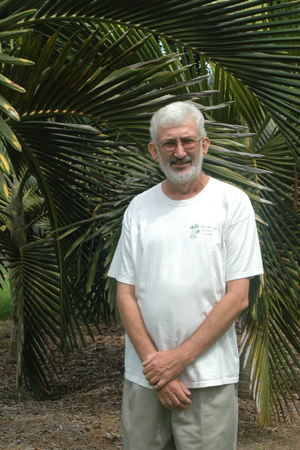 Dr. John Leslie Dowe is a Research Botanist based at James Cook University, Townsville, Australia and a Research Fellow with Montgomery Botanical Center. Dr. Dowe has worked on the systematics, ecology and taxonomy of Australia palms for the last 20 years.
Dr. John Leslie Dowe is a Research Botanist based at James Cook University, Townsville, Australia and a Research Fellow with Montgomery Botanical Center. Dr. Dowe has worked on the systematics, ecology and taxonomy of Australia palms for the last 20 years.
John has provided revisions of the Australian palm genera of Archontophoenix (1994), Caryota (1994), Linospadix (1997), Licuala (2005), and Livistona (2009). His work in the south-west Pacific and New Guinea has included a taxonomic account of the palms of Vanuatu (1996), a revision of Calyptrocalyx (2001) and research into the rare and threatened species Carpoxylon macrospermum (1989, 1997). In February of 2010 Dr. Dowe published the definitive reference work on Australian palms: ‘Australian Palms: Biogeography, Ecology and Systematics’, published by CSIRO Publishing, Australia.
Dr. Dowe presented two talks on Livistona, one at Fairchild Tropical Botanic Garden for the South Florida Palm Society and one in Orlando for the Central Florida Palm and Cycad Society. Dr. Dowe also presented two lectures on the public palm collections of North Queensland, Australia, one in Largo, FL and one here at Montgomery Botanical Center. The talk presented at MBC titled, “A Palm Road-Trip: Visiting the Public Palm Collections of North Queensland, Australia” focused on the many interesting palms found at each of six public gardens.
While in Miami, Dr. John Dowe and Dr. Larry Noblick used the scanning electron microscope at the University of Miami to look at the surface textures of different Australian palm pollen grains that were collected in Australia and in the United States at Fairchild Tropical Botanic Garden and Montgomery Botanical Center. Dr. Dowe has been using Montgomery Botanical Center’s living collection since 1996. Actively supporting research is an integral component of the mission here at MBC.
The Montgomery Botanical Research Fellows Program is generously supported by the Kelly Foundation, in order to advance research on the MBC living collection and share this research with the botanical community.
